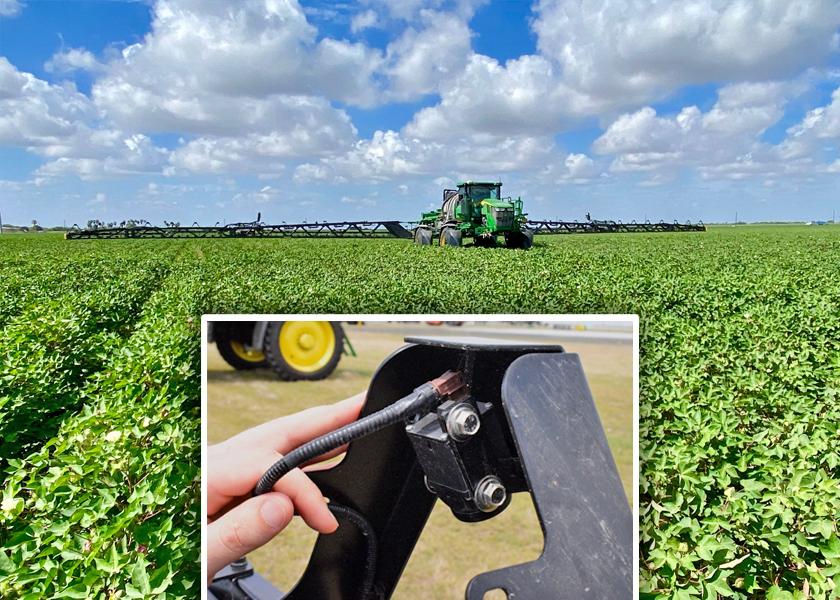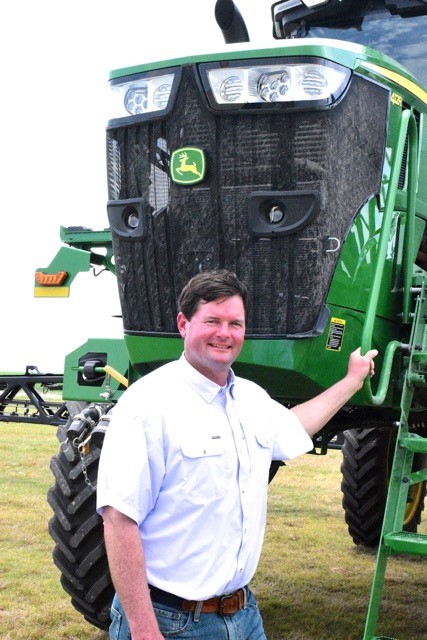Texas Grower Puts John Deere’s See and Spray Technology to the Test

Like most growers, Sam Sparks has dealt with high input costs and herbicide shortages when weed control is critical to his row crop operation. That’s why he’s not afraid to trust artificial intelligence (AI) to cut herbicide usage and improve post-emerge weed management on his Mercedes, Texas farm.
In test trials on his 2021 cotton crop, Sparks says he was able to cut herbicide treatments by up to 80% using John Deere’s See & Spray Ultimate AI technology. He saw similar results this summer and enjoyed huge savings in herbicide costs and better weed control. He also feels there is a reduced chance for weed resistance, less labor required and an opportunity to improve soil health.
John Deere intends to have See & Spray Ultimate commercially available this year. Sparks plans to continue to use the system’s targeted in-crop-spraying technology on his 10,000-acre operation in the Lower Rio Grande Valley.
About 5,000 of his acres are in cotton this year with the remainder in corn, sorghum and soybeans. Most crops depend on supplemental water using furrow irrigation fed from wells and the Rio Grande.
“Despite good rains in May, water is scarce this year. We’ll have maybe 40% of what we typically see in water availability,” Spark says. “We planted more cotton and sorghum, which are more drought-tolerant crops.”
Sparks has long used John Deere equipment and the JDLink precision ag connectivity system. He also uses AgKeeper farm management software from AgriSompo to help map planting information and track inputs. Through JDLink connectivity, the See & Spray data is automatically visualized in the John Deere Ops Center App, he says. Through John Deere’s Open API platform, the data feeds into AgKeeper.

The See & Spray unit is mounted on a John Deere 600 series sprayer. The booms are equipped with 36 cameras equally spaced across the 120’ span. Using technology developed by Blue River Technology (purchased by John Deere in 2017), the cameras can identify weeds and immediately spray them, without spraying the entire field.
The system features two independent tanks with up to 1,200 gal. of capacity. One works off the See & Spray system to target weeds. The other is a broadcast system that can apply a separate chemical or tank mix.
“One pass can do the work of two passes,” Sparks says. “We can apply herbicide to targeted weeds through one tank and fungicide for disease management through the broadcast tank.”
$25 to $35 Per Acre Savings in Herbicide Costs
Justin Chopelas, an independent crop consultant for the Texas Coastal Bend and Rio Grande Valley, says the region’s typical herbicide costs range from $11.25 per acre for Roundup Powermax and $12.30 per acre for Engenia to $25 per acre for Liberty. If a program such as See & Spray can cut herbicide applications by 50% to 75% or more that’s a savings of nearly $25 to $35 per acre.
In Kleburg County outside Corpus Christi, Chopelas has seen growers reduce herbicide usage by 60% or more with See & Spray technology.
“That type of herbicide management could heavily reduce the costs of weed control. And it should help growers better manage weed resistance,” he says.
Sparks’ weed problems center around sunflowers, ragweed, Texas Panicum grass, nutgrass and pigweed. His typical cotton herbicide program involves pre-emerge application of 3 pints of Warrant per acre, followed by post-emerge Liberty applications at 24 oz. to 32 oz. per acre to control escapes, grasses or broadleaves.
“In the past we used a John Deere self-propelled sprayer making predominately broadcast applications,” Sparks says. “In some cases, we attempted to spot spray by turning the boom sections on and off across the field where weed pressure is heavy.
“See and Spray has helped save a substantial amount on herbicide. We have seen as high as 80% savings on herbicide usage because the system’s camera program instantly sprays only where it detects weeds in the field,” he adds. “With chemicals in short supply and prices extremely high, this savings is imperative when seeking profitability.”
Sparks says the new technology again proved its worth in late May 2022 following several inches of rain.
“After pre-emerge herbicide treatments, we had pigweed come through cotton as it emerged,” he says. “It made it through the first bloom stage on about 5% of the field. “That’s where we saw the benefit of See & Spray. It targeted those few plants in the 80-acre plot and only sprayed them.”
Sustainability Wins
Sparks pushes to use fewer chemicals and improve soil conditions and has dedicated his cotton program to the U.S. Cotton Trust Protocol. The protocol helps assure domestic and foreign buyers that U.S. cotton is sustainably produced on farms high on stewardship.
“See and Spray allows us to cut our overall herbicide usage far beyond what we had initially thought,” Sparks explains. “This will help us improve soil quality and ensure clean water, whether it’s applied from irrigation or runoff into natural waterways and habitats.”
How It Works
Franklin Peitz, a John Deere marketing manager, says the newest sprayer technology goes beyond individual nozzle control, which allows users to spray row by row.
“See & Spray provides plant-level control with AI,” he explains, adding users can apply “only what you need when and where you want it.”
See & Spray applications can be made during daylight and at speeds of 9 mph to 12 mph. When switching to the broadcast tank, typical speeds can increase to 25 mph. Peitz says the BoomTrac Ultimate control keeps the tip of the boom within 10” of the target height 95% of the time to improve spray accuracy.
Whether it’s cotton, corn or soybeans, the AI technology uses its cameras to capture plant images. Camera processors then determine whether a plant is a weed or a crop, then sends a signal to the nozzle to spray. All that happens in 0.2 seconds, or the blink of the eye, Peitz says.
“If you’re doing a foliar or plant growth regulator application, the cameras will pick up the pigweed and you can spot spray them,” Sparks adds. “You’ll waste a lot of chemical if you’re just doing it by broadcast.”
Bonus: Tackle Weed Resistance
High herbicide cost might tempt farmers to reduce application rates, Sparks says, which could increase the chance of herbicide resistance.
“With this new technology, you reduce overall spray volume. Instead of using a lower rate of 14 oz. of Liberty per acre, you can apply the full rate of 24 oz. and not worry about having enough chemical for all acres,” he explains. “This technology is different than what we’ve seen in the past. We’re not talking more horsepower or wider equipment. This type of technology will help farmers cut back on their herbicide usage, saving time and money. It’s a bonus to help us to tackle weed resistant issues.”
Data sent from the sprayer technology to Sparks’ precision operations center can help develop field mapping and other production tactics to improve efficiency.
“With this and other technology, we’re able to manage our labor and time more efficiently,” he says. “And as all farmers know, timing is everything.”







